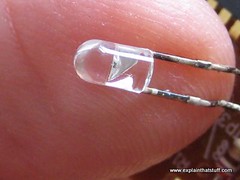The Li-Fi consortium reckons more than 10 Gbps is possible
AMONG the many new gadgets unveiled at the recent Consumer Electronics Show in Las Vegas was a pair of smartphones able to exchange data using light. These phones, as yet only prototypes from Casio, a Japanese firm, transmit digital signals by varying the intensity of the light given off from their screens. The flickering is so slight that it is imperceptible to the human eye, but the camera on another phone can detect it at a distance of up to ten metres. In an age of Wi-Fi and Bluetooth, flashing lights might seem like going back to sending messages with an Aldis lamp. In fact, they are the beginning of a fast and cheap wireless-communication system that some have labelled Li-Fi.
The data being exchanged by Casio’s phones were trifles: message balloons to be added to pictures on social-networking sites. But the firm sees bigger applications, such as pointing a smartphone at an illuminated shop sign to read information being transmitted by the light: opening times, for example, or the latest bargains.
Yet that is still only a flicker of what is possible. Last October a number of companies and industry groups formed the Li-Fi Consortium, to promote high-speed optical wireless systems. The idea is that light can help with a looming capacity problem. As radio-based wireless becomes ubiquitous, more and more devices transmitting more and more data are able to connect to the internet, either through the mobile-phone network or through Wi-Fi. But there is only a limited amount of radio spectrum available. Using light offers the possibility of breaking out of this conundrum by exploiting a completely different part of the electromagnetic spectrum, one that is already ubiquitous because it is used for another purpose: illumination.
Lighten the darkness
To turn a light into a Li-Fi router involves modulating its output, to carry a message, and linking it with a network cable to a modem that is connected to a telephone or cable-broadband service, just like a Wi-Fi router. Incandescent light bulbs and fluorescent tubes are not really suitable for modulation, but they are yesterday’s lighting technology. Tomorrow’s is the light-emitting diode. LEDs are rapidly replacing bulbs and tubes because they are more efficient. And because they are semiconductor devices, tinkering with their electronics to produce the flickering signals required for data transmission is pretty straightforward, according to Gordon Povey, who is working on light communication with Harald Haas and his colleagues at the University of Edinburgh, in Britain.
The rate of data transfer is also good. Dr Povey’s group is already up to 130 megabits a second (faster than some older Wi-Fi routers) over a distance of about two metres, using standard LEDs. Dr Povey, who is also the boss of VLC, a firm set up to commercialise the technology, thinks such devices should be able to reach 1 gigabit per second (Gbps), and do so over greater range. Specially constructed LEDs would be even faster. The Li-Fi consortium reckons more than 10 Gbps is possible. In theory, that would allow a high-definition film to be downloaded in 30 seconds.
Dr Povey believes that adapting existing LEDs to work with the sensors and light sources—cameras, ambient-light detectors, screens, flashbulbs, torches and so on—already found in smartphones and similar devices will be the fastest way to bring Li-Fi to market. VLC has already produced a smartphone app which allows low-speed data transmission between a pair of iPhones. It has also made an experimental optical transceiver that plugs into a laptop to receive and send light signals. Later this year it will bring out Li-Fi products for firms installing LED-lighting systems.
Bookmark this page for “LED communications” and check back regularly as these articles update on a frequent basis. The view is set to “news”. Try clicking on “video” and “2” for more articles.








